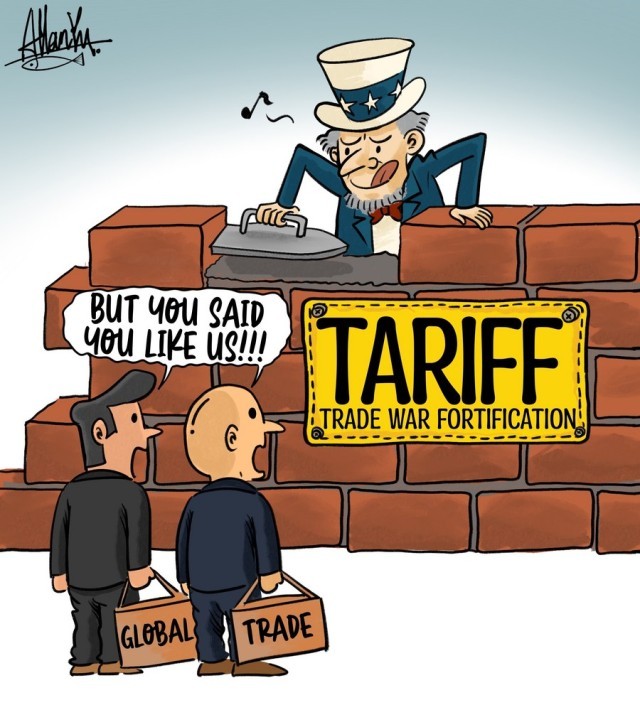Trump's China Negotiation Strategy: Tariff Relief And Rare Earths A Key Focus

Table of Contents
The Tariff Relief Approach: A Double-Edged Sword
Trump's strategy initially involved imposing significant tariffs on a wide range of Chinese goods, aiming to pressure China into trade concessions. This approach, however, proved to be a double-edged sword.
Initial Tariff Impositions and Their Impact
The rationale behind the initial tariff increases was to address what the administration perceived as unfair trade practices, intellectual property theft, and a persistent trade deficit. These tariffs, imposed in stages, targeted various sectors:
- Specific examples of tariffs imposed: 25% tariffs on steel and aluminum, 25% tariffs on hundreds of billions of dollars worth of manufactured goods.
- Industries affected: Agriculture (soybeans), manufacturing (electronics, textiles), and technology sectors were significantly impacted.
- Initial economic consequences: Increased prices for consumers, uncertainty for businesses, and retaliatory tariffs from China, leading to disruptions in global supply chains.
Counterarguments emerged, suggesting that the short-term pain of tariffs was necessary for long-term gains in securing better trade deals. The administration viewed tariffs as a powerful bargaining chip in negotiations.
Negotiated Tariff Reductions and Their Limitations
While tariffs were initially imposed aggressively, there were instances of negotiated tariff reductions. These reductions, however, often came with conditions:
- Examples of tariff reductions: Phased reductions in some tariffs following the "Phase One" trade deal.
- Conditions of the reductions: China committed to purchasing a significant amount of US agricultural products.
The effectiveness of these tariff reductions in achieving their intended goals remains a subject of debate. While some sectors experienced relief, others continued to face challenges due to lingering trade tensions and the complexities of global supply chains.
The Ongoing Debate over Tariff Policy
The long-term consequences of Trump's tariff policies continue to be debated among economists and political analysts:
- Long-term economic consequences of tariff policies: Some studies suggest negative impacts on economic growth, while others point to potential benefits in specific sectors.
- Arguments for and against continued tariff usage: Supporters argue that tariffs can be a useful tool in addressing trade imbalances and protecting domestic industries. Opponents emphasize the negative effects on consumers and global trade.
Rare Earths: A Geopolitical Power Play
Rare earth minerals are critical components in a vast array of modern technologies, from smartphones and electric vehicles to military equipment and renewable energy technologies. China's dominance in the production and processing of these minerals presents a significant geopolitical challenge.
The Strategic Importance of Rare Earths
The strategic importance of rare earths cannot be overstated:
- Key applications of rare earths: Magnets, catalysts, electronics, lasers, and defense applications.
- China's market share and its strategic implications: China controls a substantial portion of the global rare earth supply chain, giving it considerable leverage in international relations.
Trump Administration's Efforts to Diversify Rare Earth Supply Chains
Recognizing the vulnerability posed by China's dominance, the Trump administration initiated several efforts to diversify rare earth supply chains:
- Specific policy initiatives and programs: Investments in domestic rare earth mining and processing, exploration of alternative sources, and partnerships with allied countries.
- Assessment of the success of these initiatives: While progress was made, fully decoupling from China's dominance remains a significant long-term challenge.
The Future of Rare Earth Dependence
The geopolitical implications of rare earth dependence are far-reaching:
- Potential sources of rare earths outside of China: Australia, Brazil, and the United States possess rare earth deposits, but developing these resources requires significant investment and time.
- Challenges in developing alternative supply chains: These challenges include environmental concerns, technological hurdles, and the need for substantial capital investment.
Conclusion: Assessing the Legacy of Trump's China Negotiation Strategy
Trump's China negotiation strategy, characterized by its use of tariff relief as a bargaining tool and a strategic focus on reducing reliance on China for rare earth minerals, left a complex and enduring legacy. While some tariff reductions brought temporary relief, the overall effectiveness of the tariff approach remains contentious. Similarly, efforts to diversify rare earth supply chains have yielded some progress but face significant ongoing challenges.
Key Takeaways: The strategy highlighted the intricate interplay between trade policy, national security, and global economic dynamics. While some objectives were partially achieved, the long-term consequences of this approach continue to unfold, impacting US-China relations and the global economic landscape.
Call to Action: To further understand the intricate details and lasting implications of Trump's China negotiation strategy, further research into US-China trade relations, the economics of tariff policies, and the geopolitical significance of rare earth minerals is strongly encouraged. The ongoing impact of these policies will continue to shape future administrations' approaches to these critical issues.

Featured Posts
-
 Aer Mls Naesta Steg Foer Thomas Mueller En Djupdykning I Ryktena
May 12, 2025
Aer Mls Naesta Steg Foer Thomas Mueller En Djupdykning I Ryktena
May 12, 2025 -
 The Papal Election Key Cardinals To Watch
May 12, 2025
The Papal Election Key Cardinals To Watch
May 12, 2025 -
 Guardians Vs Yankees Whos On The Injured List April 21 23
May 12, 2025
Guardians Vs Yankees Whos On The Injured List April 21 23
May 12, 2025 -
 Cheetah Print And Blue Fur Jessica Simpsons Head Turning Airport Outfit
May 12, 2025
Cheetah Print And Blue Fur Jessica Simpsons Head Turning Airport Outfit
May 12, 2025 -
 Trump Tariffs A New York Courts Crucial Decision
May 12, 2025
Trump Tariffs A New York Courts Crucial Decision
May 12, 2025
